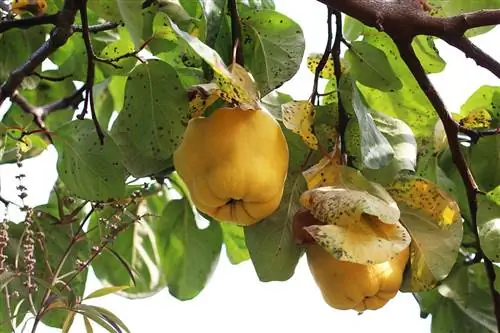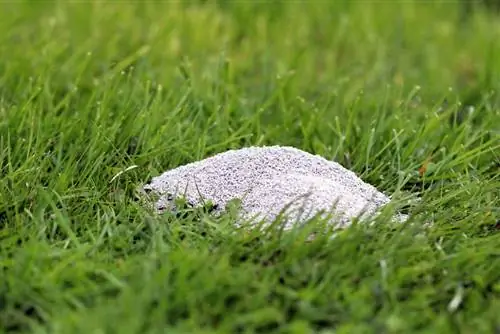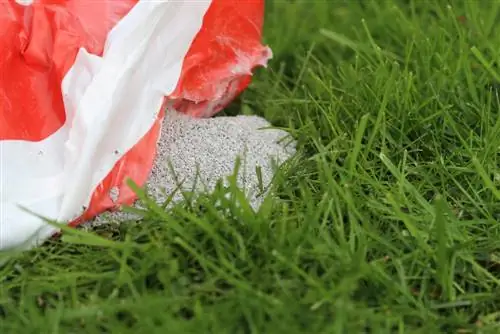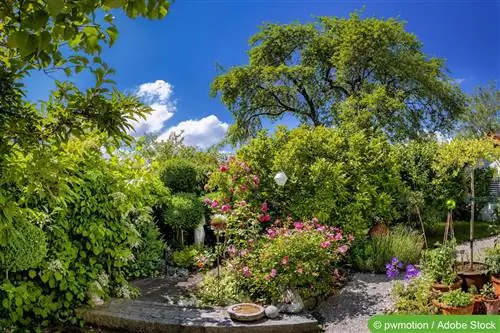- Author admin [email protected].
- Public 2023-12-17 03:39.
- Last modified 2025-06-01 06:48.
In nature, trees provide themselves with nutrients and thus maintain the nutrient cycle. The conditions for this are usually not met in the garden, either because the soil is too poor or because there is competition from other trees. When it comes to deciduous trees, a distinction is made between ornamental and fruit trees.
Fertilizing deciduous trees - basics
Deciduous trees can take on different functions in the garden, whether as shade, privacy screens, ornamental or fruit trees. In addition to the main nutrients nitrogen, phosphorus and potassium, all woody plants also need sufficient amounts of minerals and trace elements. Factors that influence the respective nutrient requirement are the tree species, location, condition of the soil and size of the tree, lighting conditions and weather. Trees with greater root depth can absorb significantly more nutrients. In nature, important nutrients are supplied to the soil through weathering processes. This creates a natural nutrient cycle.
This could also work in the garden, but this process is often disrupted here. This is due, among other things, to the fact that in many cases falling leaves are removed regularly, so that no rotting can take place on site and important nutrients are lost. These must then be balanced with appropriate tree fertilizer.
Types of tree fertilizers
There are basically two different fertilizers, organic and mineral fertilizers:
Organic fertilizers
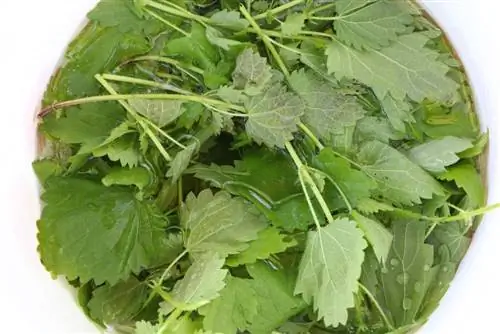
Organic fertilizer is created through the decomposition of naturally occurring organic substances. Vegetable nutrients, which are initially removed from the soil for the growth of the plants, are added back to it after they die, the natural cycle is continually closed.
- Very good organic fertilizers are compost, manure and plant manure
- Rock dust, horn shavings and horn meal are also well suited
- Compost contains all important nutrients and trace elements
- Rock dust consists of ground rock powder
- Horn shavings and horn meal are waste products from animal production
- Effect of organic fertilizer, only starts after the substances have decomposed
- It works more slowly, but over a longer period of time
- Overfertilization occurs less often
Tip:
Organic tree fertilizers should always be preferred over mineral fertilizers. They are more environmentally friendly and can prevent damage to he alth when eating fruit, due to improper use of mineral fertilizers.
Mineral fertilizers
Despite the positive properties of organic tree fertilizers, there are quite a few fans of mineral fertilizers among hobby gardeners. The nutrients it contains are available to plants more quickly because they are easier and more quickly soluble. Results are visible after just a short time. But often the dosage is not optimal. Over-fertilization occurs, which has a lasting impact on the environment because the soluble components are also washed into the groundwater.
Exclusive use of mineral fertilizers, also known as artificial fertilizers, can weaken important soil organisms so that the soil is no longer adequately aerated. The result is erosion damage and soil compaction. As tree fertilizer, residues can accumulate in the ripe fruit, especially in fruit trees, and thus enter the food chain. In addition, an excess of nitrogen can reduce yields.
Damage caused by over-fertilization can also be observed on other deciduous trees. The foliage may turn yellow and burn. In addition, affected plants are generally significantly more susceptible to frost damage, pests and diseases. Despite everything, mineral fertilizers can also provide deciduous trees with all the important nutrients, as long as the dosage is right. Frequently used fertilizers include blue grain, lime, lime ammonium nitrate or so-called NPK fertilizers.
Tip:
In addition to these types of fertilizer, there are also organic-mineral fertilizers, a mixture of both. However, they offer no advantages over purely organic or purely mineral tree fertilizers.
Function of individual ingredients
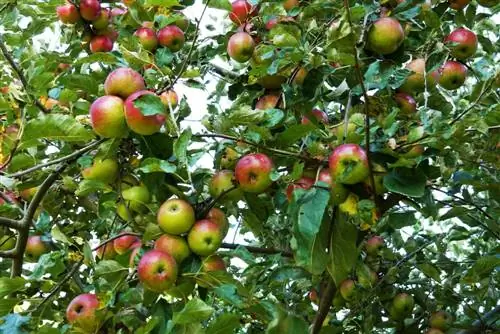
Only when trees are adequately supplied with all the necessary nutrients can many new shoots, flowers or fruits develop. The most important elements in both organic and mineral fertilizers are nitrogen, phosphorus and potassium. In addition, minerals such as sulfur, calcium and magnesium and trace elements such as iron, manganese, copper and zinc are required. Each of these elements fulfills a specific function for the tree's metabolism. They interact directly with each other and should always be present in a balanced ratio in the soil.
Phosphorus (P)
- Phosphorous fertilizers preferably suitable for fruit trees that both flower and fruit
- Phosphorus promotes the development of flowers, fruits and seeds
- Supports the formation of he althy and strong roots
- Required by flowering and fruit-bearing deciduous trees
- Too high nitrogen content in the soil can hinder the absorption of phosphorus
- Too much phosphorus leads to stunted growth
- It hinders the absorption of important trace elements
- Optimal phosphorus content in rich flower flora, fruit set and fruit ripeness can be seen
Nitrogen (N)
Nitrogen primarily stimulates the growth of green parts of plants. In principle, nitrogen-based fertilizers, so-called 'green manures', are suitable for trees, which are particularly concerned with their foliage. The nitrogen used in mineral tree fertilizers is usually produced synthetically. A nitrogen deficiency reduces growth and causes leaves to turn pale green or yellow. An excess of nitrogen leads to soft, unstable tissue and fattening leaves. It usually also brings with it increased exposure to nitrates. An optimal nitrogen content in the soil is reflected in normal growth and lush green foliage.
Potassium (K)
Potassium is a natural component of the soil. It ensures the formation of a stable plant framework, promotes the formation of roots, tubers and fruits and their strength. It is also needed for the transport of water and nutrients and makes plants more resistant to frost and pests. An undersupply of potassium leads to a variety of deficiency symptoms such as stunted growth, wilting, limp and discolored leaves, and increased susceptibility to diseases. Too much potassium can stunt growth and cause root burns, leaf damage, and stunted growth. If the tree looks he althy, grows steadily and quickly, the potassium content is ideal.
When to fertilize?
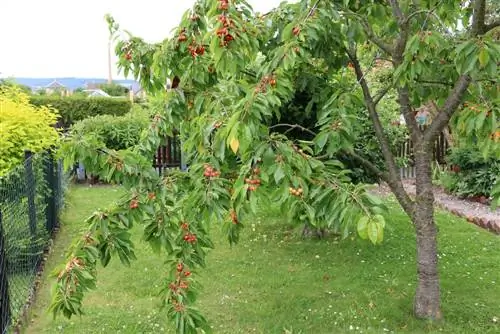
Deciduous trees use their falling leaves to supply themselves with all important nutrients. You can help them by using a rake to spread surrounding leaves onto the tree disk and slightly beyond it. The rest is done by microorganisms in the soil. When fertilizing deciduous trees, less is more.
- Deciduous trees do not necessarily have to be fertilized every year
- Every two years is sufficient
- Always only fertilize during the growing season
- At the start of budding in March/April and at the end of shoots around June 24th
- Effect of organic fertilizer is delayed
- Lead time of 3 - 4 weeks recommended
- Depending on soil moisture content and temperature
- Mineral fertilizers are water-soluble and immediately available to plants
In autumn and winter, during the rest period, fertilizer is completely avoided, because then plants do not absorb any nutrients. If you still fertilize at other times, you risk that the plants will not mature. The soft shoots are sensitive to frost and can be damaged. Frequency and timing of fertilization also depend on the age of the tree.
Young trees that were provided with compost when planted do not need any additional fertilizer this year. The compost provides it with all the important nutrients in the first year. A thick layer of mulch on the root area prevents competition from other plants that could deprive the tree of nutrients.
Instructions for fertilizing
Before you start fertilizing, it is recommended to determine the actual nutrient requirements by conducting a soil analysis in the area around the tree disc. Once the result is clear, you should first consider that the root system of a deciduous tree is usually slightly wider than the crown, so that there are also fine, so-called suction roots outside the crown eaves.
If the tree disc is not overgrown or is open, you can spread a thin layer of fertilizer over the entire area and slightly beyond. Then work it lightly into the ground with a rake. Then spread a layer of mulch on top, which should be renewed every year.
To fertilize deciduous trees that grow in the lawn or in a meadow, it usually makes no sense to simply spread the fertilizer. It should be introduced below the turf by making small holes at regular intervals on the tree disc with a lawn aerator, adding the fertilizer and, if necessary, slurrying it in with water.
Fruit trees should not be in the lawn or meadow if possible; without an open tree window, competition for food from the grasses is very strong, especially for young trees. In addition, it should never be applied to dry soil as this would burn the roots. Depending on the type of fertilizer, it is better to apply it after a rainstorm or with irrigation water.
Tip:
For a corresponding soil analysis, it is advisable to always take samples from different parts of the tree disc in order to obtain a representative result. Such soil analyzes should be repeated approximately every 4 - 5 years.
Organic fertilization

Deciduous trees that do not bear fruit can largely supply themselves with nutrients by shedding their leaves in autumn. Fruit trees have slightly higher nutrient requirements. If you leave fallen fruit lying around, especially on fruit trees, this also represents a natural fertilizer. Compost is the best organic fertilizer for many hobby gardeners.
- Spread fresh or mature compost onto tree discs every 3 - 5 years
- Work lightly into the soil
- If necessary, add some primary rock powder
- Add a layer of mulch to the compost
- Lawn clippings, bark mulch or wood chips are suitable
- Administer 100 - 140 g of nitrogen fertilizer to stone fruit trees
- For pome fruit 70 - 100 g per tree is sufficient
- For young plants, reduce the amount of fertilizer by around 75%
- Some wood ash can increase potassium levels in the soil
- Supply important trace elements with algae lime or rock dust
Compost is less suitable as a fertilizer for lime-sensitive deciduous trees such as rhododendrons, dogwoods or magnolias. Another good organic fertilizer is manure, in the form of horse, sheep, cattle, rabbit or chicken manure. It should be noted that manure should never be applied fresh, but only when it is well rotted. It should be spread over the area in question approximately every three years in the fall and buried shallowly. By the way, cattle dung is also available in the form of pellets.
Tip:
Before applying bark mulch, you should ensure a good supply of nitrogen, because bark mulch in particular removes a lot of nitrogen from the soil. That's why it makes sense to mix the compost with horn shavings or horn meal (nitrogen fertilizer) to avoid undersupply.
Mineral fertilization
Severe deficiencies in the soil can be compensated relatively quickly with mineral fertilizers. Although they do not build up humus, they still provide the trees with all the nutrients they need. The main problem here is the correct dosage, so that oversupply or over-fertilization occurs relatively quickly, which harms the tree rather than helping it.
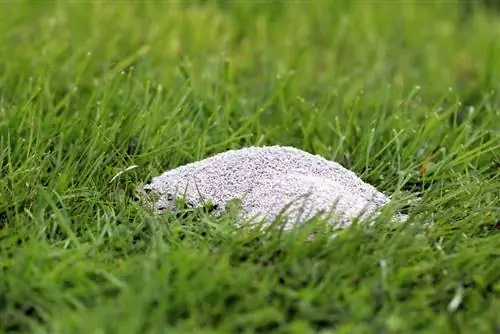
The most common mineral fertilizers for deciduous trees, especially fruit trees, are lime ammonium nitrate and blue grain. These fertilizers are best applied to the soil in two separate doses. As a rule, 15 - 20 g of the fertilizer is sufficient. The need for older trees is slightly higher. Quantities of 50 - 60 g are recommended here.
Tip:
If you decide on a mixture of organic and mineral fertilizers, you should use a nitrogen-based complete fertilizer if possible.
Detecting nutrient deficiencies
Signs of a nutrient deficiency can be, for example, declining growth. If leaves noticeably lose color and become lighter and brighter, this may indicate chlorosis. This is usually caused by a lack of mineral nutrients such as magnesium and iron. But there are also plants, so-called indicator plants, that indicate an existing deficiency. These include the nettle, whose occurrence is particularly high on very nitrogen-rich soils. On the other hand, arthropod and chamomile can be signs of a nitrogen deficiency.
Sorrel, horsetail and bracken thrive particularly well on soils with a low lime content. Heather, meadow sorrel and daisies love nutrient-poor soil. To be sure whether there is a deficiency or a surplus, you cannot avoid a corresponding soil analysis, which should ideally be repeated every few years.


